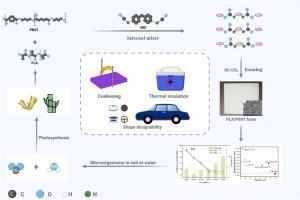Lightweight and insulation polylactide/poly(butyleneadipate-co-terephthalate) foam with good cushioning performance prepared by supercritical CO2
IF 5.6
1区 农林科学
Q1 AGRICULTURAL ENGINEERING
引用次数: 0
Abstract
Herein, biodegradable polylactide (PLA) foams were prepared by supercritical CO2. To address the foaming challenges posed caused by the low crystallization rate and the weak melt strength of PLA, the blending of PLA and poly(butyleneadipate-co-terephthalate) (PBAT) was adopted in this work, the diphenylmethane diisocyanate (MDI) was utilized to boost the compatibility and rheological features of the PLA/PBAT combination. The effects of MDI and PBAT on the crystallization and rheological of the blends were studied. In PLA/PBAT foam, the density prepared was adjustable from 0.02 to 0.025 g/cm3, and the heat-conductivity was a minimum of 0.028 W/(m·K). In addition, the effect of PBAT on PLA cushioning performance was studied, the PLA/PBAT foam prepared has good mechanical properties, which can be used for cushioning packaging and heat insulation. The hardness of the PLA/PBAT blend foam slowly reduced as the PBAT increased, and the elasticity gradually increased. Notably, with 10 phr of PBAT, the compressive strength of the blend foam at 25 ℃ and 60 ℃ was 57 KPa and 55 KPa, respectively. This work broadens the application prospect of PLA and has a positive impact on promoting the high-value utilization of biobased polymers.

利用超临界二氧化碳制备具有良好缓冲性能的轻质隔热聚乳酸/聚(丁烯二酸酯-对苯二甲酸酯)泡沫塑料
本文利用超临界二氧化碳制备了可生物降解的聚乳酸(PLA)泡沫。为了解决聚乳酸结晶率低和熔体强度弱所带来的发泡难题,本研究采用了聚乳酸与聚对苯二甲酸丁二醇酯(PBAT)共混的方法,并利用二苯基甲烷二异氰酸酯(MDI)来提高聚乳酸/PBAT组合的相容性和流变特性。研究了 MDI 和 PBAT 对混合物结晶和流变的影响。在聚乳酸/PBAT 泡沫中,制备的密度可在 0.02 至 0.025 g/cm3 之间调节,导热系数最小为 0.028 W/(m-K)。此外,还研究了 PBAT 对聚乳酸缓冲性能的影响,制备的聚乳酸/PBAT 泡沫具有良好的机械性能,可用于缓冲包装和隔热。随着 PBAT 的增加,聚乳酸/PBAT 混合物泡沫的硬度缓慢降低,弹性逐渐增加。值得注意的是,在 PBAT 含量为 10 phr 的情况下,混合泡沫在 25 ℃ 和 60 ℃ 的抗压强度分别为 57 KPa 和 55 KPa。这项研究拓宽了聚乳酸的应用前景,对促进生物基聚合物的高值化利用具有积极意义。
本文章由计算机程序翻译,如有差异,请以英文原文为准。
求助全文
约1分钟内获得全文
求助全文
来源期刊

Industrial Crops and Products
农林科学-农业工程
CiteScore
9.50
自引率
8.50%
发文量
1518
审稿时长
43 days
期刊介绍:
Industrial Crops and Products is an International Journal publishing academic and industrial research on industrial (defined as non-food/non-feed) crops and products. Papers concern both crop-oriented and bio-based materials from crops-oriented research, and should be of interest to an international audience, hypothesis driven, and where comparisons are made statistics performed.
 求助内容:
求助内容: 应助结果提醒方式:
应助结果提醒方式:


